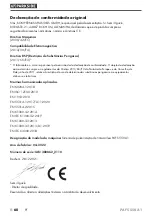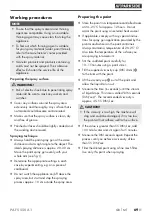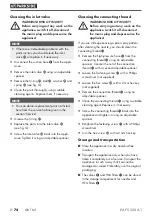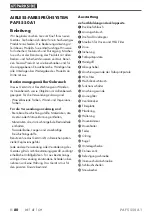
PAFS 550 A1
GB
│
MT
│
69
■
Working procedures
NOTE
►
Ensure that the spray material and thinning
agent are compatible. Using an unsuitable
thinning agent may cause clots that clog the
appliance.
►
To find out which thinning agent is suitable
for your spray material (water, paint thinner),
refer to the manufacturer's notes provided
with the spray material.
►
Granular products and products containing
solids must not be sprayed. Their abrasive
effect will shorten the service life of the
appliance.
Preparing the spray surface
WARNING!
►
Risk of electric shock due to penetrating spray
material! Be sure to mask any sockets and
switches.
♦
Cover any surfaces around the spray area
extensively and thoroughly. Any surface that is
not masked could become contaminated.
♦
Make sure that the spray surface is clean, dry
and free of grease.
♦
Polished surfaces should be lightly sanded and
the sanding dust removed.
Spraying technique
♦
Always hold the paint spray gun at the same
distance and at a right angle to the object. The
ideal spraying distance is approx. 20–30 cm.
Move the paint spray gun evenly with your
whole arm (see fig. J).
♦
Determine the appropriate settings in each
case by experimenting, e.g. on a piece of
cardboard.
♦
Do not switch the appliance on/off above the
spray area, but start and stop the spraying
process approx. 10 cm outside the spray area.
Preparing the paint
♦
Store the paint in a temperature-controlled room
at 20–25°C for approx. 12 hours. Do not
warm the paint using an external heat source!
♦
If applicable, comply with any special instruc-
tions for spray gun application provided by the
paint manufacturer on the paint containers.
Always maintain a temperature of 20–25°C!
Also take the temperature of the surface you
are spraying into account.
♦
Stir the undiluted paint carefully for
10–15 minutes using a paint stirrer.
♦
Fill the supplied viscosity cup (DIN 4 mm)
y
to the brim with the paint.
♦
Lift the viscosity cup
y
out of the paint and
allow the liquid to run out.
♦
Measure the time (in seconds) until the stream
of liquid stops. This time is called "DIN seconds
(DIN/sec)". The recommended viscosity is
approx. 45–55 DIN/sec.
CAUTION!
►
If the viscosity is too high, the machine will
clog and could be damaged; if it is too low,
the paint will not adhere well to the surface.
♦
If the value is greater than 55 DIN/sec, add
100 ml of water and stir again for 5 minutes.
♦
Measure the DIN seconds again. Repeat the
process until you achieve a viscosity of less
than 55 DIN/sec.
♦
Filter the diluted paint using a fine mesh filter.
Use only this paint when spraying.
















































